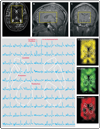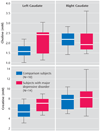Lateralized caudate metabolic abnormalities in adolescent major depressive disorder: a proton MR spectroscopy study
- PMID: 18056244
- PMCID: PMC2774821
- DOI: 10.1176/appi.ajp.2007.06122032
Lateralized caudate metabolic abnormalities in adolescent major depressive disorder: a proton MR spectroscopy study
Abstract
Objective: Proton magnetic resonance spectroscopy ((1)H-MRS) has been increasingly used to examine striatal neurochemistry in adult major depressive disorder. This study extends the use of this modality to pediatric major depression to test the hypothesis that adolescents with major depression have elevated concentrations of striatal choline and creatine and lower concentrations of N-acetylaspartate.
Method: Fourteen adolescents (ages 12-19 years, eight female) who had major depressive disorder for at least 8 weeks and a severity score of 40 or higher on the Children's Depression Rating Scale-Revised and 10 healthy comparison adolescents (six female) group-matched for gender, age, and handedness were enrolled. All underwent three-dimensional 3-T (1)H-MRS at high spatial resolution (0.75-cm(3) voxels). Relative levels of choline, creatine, and N-acetylaspartate in the left and right caudate, putamen, and thalamus were scaled into concentrations using phantom replacement, and levels were compared for the two cohorts.
Results: Relative to comparison subjects, adolescents with major depressive disorder had significantly elevated concentrations of choline (2.11 mM versus 1.56 mM) and creatine (6.65 mM versus 5.26 mM) in the left caudate. No other neurochemical differences were observed between the groups.
Conclusions: These findings most likely reflect accelerated membrane turnover and impaired metabolism in the left caudate. The results are consistent with prior imaging reports of focal and lateralized abnormalities in the caudate in adult major depression.
Figures


Similar articles
-
The kynurenine pathway in adolescent depression: preliminary findings from a proton MR spectroscopy study.Prog Neuropsychopharmacol Biol Psychiatry. 2010 Feb 1;34(1):37-44. doi: 10.1016/j.pnpbp.2009.09.015. Epub 2009 Sep 21. Prog Neuropsychopharmacol Biol Psychiatry. 2010. PMID: 19778568 Free PMC article.
-
Focal and lateralized subcortical abnormalities in unipolar major depressive disorder: an automated multivoxel proton magnetic resonance spectroscopy study.Biol Psychiatry. 2003 Oct 1;54(7):744-50. doi: 10.1016/s0006-3223(02)01908-x. Biol Psychiatry. 2003. PMID: 14512215
-
Proton magnetic resonance spectroscopy of late-life major depressive disorder.Psychiatry Res. 2009 Jun 30;172(3):210-4. doi: 10.1016/j.pscychresns.2009.01.003. Epub 2009 Mar 20. Psychiatry Res. 2009. PMID: 19303260
-
Sex differences in brain metabolites of unmedicated depressed adolescents with non-suicidal self-injury: a proton magnetic resonance spectroscopy study.J Affect Disord. 2025 Aug 1;382:167-175. doi: 10.1016/j.jad.2025.03.147. Epub 2025 Apr 19. J Affect Disord. 2025. PMID: 40258419
-
Proton magnetic resonance spectroscopy in obsessive-compulsive disorder: evidence for reduced neuronal integrity in the anterior cingulate.Psychiatry Res. 2014 Dec 30;224(3):275-80. doi: 10.1016/j.pscychresns.2014.08.012. Epub 2014 Sep 4. Psychiatry Res. 2014. PMID: 25241042
Cited by
-
An Exploratory Study of Spectroscopic Glutamatergic Correlates of Cortical Excitability in Depressed Adolescents.Front Neural Circuits. 2016 Nov 29;10:98. doi: 10.3389/fncir.2016.00098. eCollection 2016. Front Neural Circuits. 2016. PMID: 27965544 Free PMC article.
-
The kynurenine pathway in adolescent depression: preliminary findings from a proton MR spectroscopy study.Prog Neuropsychopharmacol Biol Psychiatry. 2010 Feb 1;34(1):37-44. doi: 10.1016/j.pnpbp.2009.09.015. Epub 2009 Sep 21. Prog Neuropsychopharmacol Biol Psychiatry. 2010. PMID: 19778568 Free PMC article.
-
MENDA: a comprehensive curated resource of metabolic characterization in depression.Brief Bioinform. 2020 Jul 15;21(4):1455-1464. doi: 10.1093/bib/bbz055. Brief Bioinform. 2020. PMID: 31157825 Free PMC article.
-
Prevalence of incompletely penetrant Huntington's disease alleles among individuals with major depressive disorder.Am J Psychiatry. 2010 May;167(5):574-9. doi: 10.1176/appi.ajp.2009.09070973. Epub 2010 Apr 1. Am J Psychiatry. 2010. PMID: 20360314 Free PMC article.
-
Regional homogeneity abnormalities affected by depressive symptoms in migraine patients without aura: a resting state study.PLoS One. 2013 Oct 16;8(10):e77933. doi: 10.1371/journal.pone.0077933. eCollection 2013. PLoS One. 2013. PMID: 24147100 Free PMC article.
References
-
- Brent DA. Depression and suicide in children and adolescents. Pediatr Rev. 1993;14:380–388. - PubMed
-
- Birmaher B, Ryan ND, Williamson DE, Brent DA, Kaufman J, Dahl RE, Perel J, Nelson B. Childhood and adolescent depression: a review of the past 10 years, part I. J Am Acad Child Adolesc Psychiatry. 1996;35:1427–1439. - PubMed
-
- Weissman MM, Wolk S, Goldstein RB, Moreau D, Adams P, Greenwald S, Klier CM, Ryan ND, Dahl RE, Wickramaratne P. Depressed adolescents grown up. JAMA. 1999;281:1707–1713. - PubMed
-
- Buchsbaum MS, Wu J, DeLisi LE, Holcomb H, Kessler R, Johnson J, King AC, Hazlett E, Langston K, Post RM. Frontal cortex and basal ganglia metabolic rates assessed by positron emission tomography with [18F]2-deoxyglucose in affective illness. J Affect Disord. 1986;10:137–152. - PubMed
-
- Baxter LR, Jr, Phelps ME, Mazziotta JC, Schwartz JM, Gerner RH, Selin CE, Sumida RM. Cerebral metabolic rates for glucose in mood disorders: studies with positron emission tomography and fluorodeoxyglucose F 18. Arch Gen Psychiatry. 1985;42:441–447. - PubMed
Publication types
MeSH terms
Substances
Grants and funding
LinkOut - more resources
Full Text Sources

